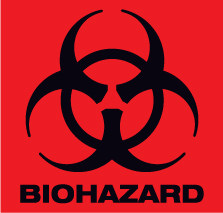Think Inside the Box When it Comes to Medical Waste Containers
Think Inside the Box When it Comes to Medical Waste Containers
 From a quiet doctor’s office to busy emergency rooms, medical waste is constantly being generated and discarded. Every ounce of waste must be treated in the same manner or else infections can be an issue inside and outside the facility. When it comes to medical waste containers, it’s important to think inside of the box for safety’s sake.
From a quiet doctor’s office to busy emergency rooms, medical waste is constantly being generated and discarded. Every ounce of waste must be treated in the same manner or else infections can be an issue inside and outside the facility. When it comes to medical waste containers, it’s important to think inside of the box for safety’s sake.
Thickness and OSHA Compliance Counts
When you’re dealing with biohazard waste disposal, the containers that you use must be of high quality. In fact, OSHA, or the Occupational Safety and Health Administration, requires plastic containers to be made to a certain thickness. The plastic itself must also be designed with certain stability. Take a look inside of your medical waste containers. The red hue shouldn’t be translucent, and sturdiness must be obvious as you pick up the item. Hazardous waste cannot accidentally drip or break through the seams on these containers.
A Box Within a Box
You’ll discover several biohazard waste disposal boxes with an extra security feature in any medical facility. Sharps containers will often have a glass box that surrounds them. This box is locked with only everyday access through the flap at the top. The extra security on the box ensures that the sharps trapped inside won’t fall out during frequent container access. Waste disposal employees have access to the glass box by way of a key. Without the proper key, the sharps remain safe from any accidental contact with others.
Considering Cardboard and Plastic Bags
Some medical facilities use marked cardboard boxes filled with plastic bags to transport their waste. The cardboard has the official biohazard waste disposal logo on almost every side. You’ll need to use the official red bags to fill this container. Although these containers are safe for linens and other lightweight items, most facilities prefer the plastic alternatives. There are no bags involved with plastic receptacles, which results in fewer preparation tasks. Medical facilities must weigh their options when it comes to disposable containers and reusable, plastic types.
Examining the Wheeled Options of Medical Waste Containers
Waste containers remain on the floor as you go about your workday. These fixed receptacles have basic, rectangular interiors so that space is optimized. Some facilities, however, need more transport options with their containers. Facilities managers can select containers with wheels for easy transport. The containers have two wheels so you can lean it back for a quick move around the facility. Be aware that some of the containers’ interiors will look slightly smaller with the wheels installed. If you want to maximize every square inch of the container, pick a model with a basic shape.
Relying on Lids and Locks
The contents inside the biohazard waste containers won’t be secure without a lid and lock. As you work around a medical facility, take some time to check the lids. These covers must lock onto the container with an actual keyhole to secure all items. The items inside the container should never overflow. If you notice an overflowing container, notify a supervisor and keep people away from the area. Sharps, bodily fluids and other hazards can easily infect others without a lid and lock intact.
Speak up if you notice improper biohazard waste disposal occurring on your watch. If an employee misunderstands the protocols, everyone can be at risk for infection or illness. Medical waste containers must be handled by trained professionals at all times. Waste disposal companies will provide training to individuals who aren’t familiar with the handling procedures. This will help you and the entire facility stay safe.








